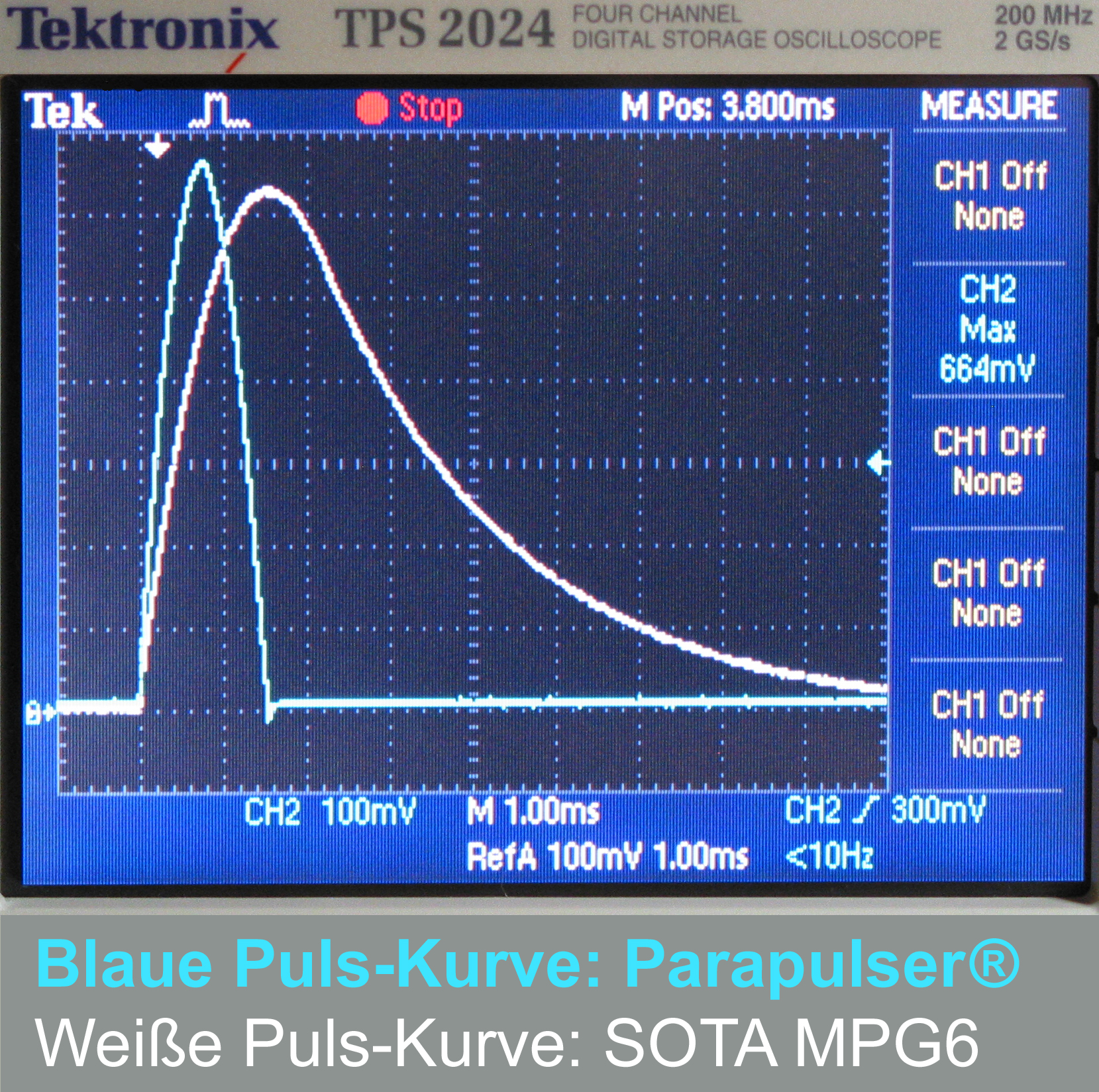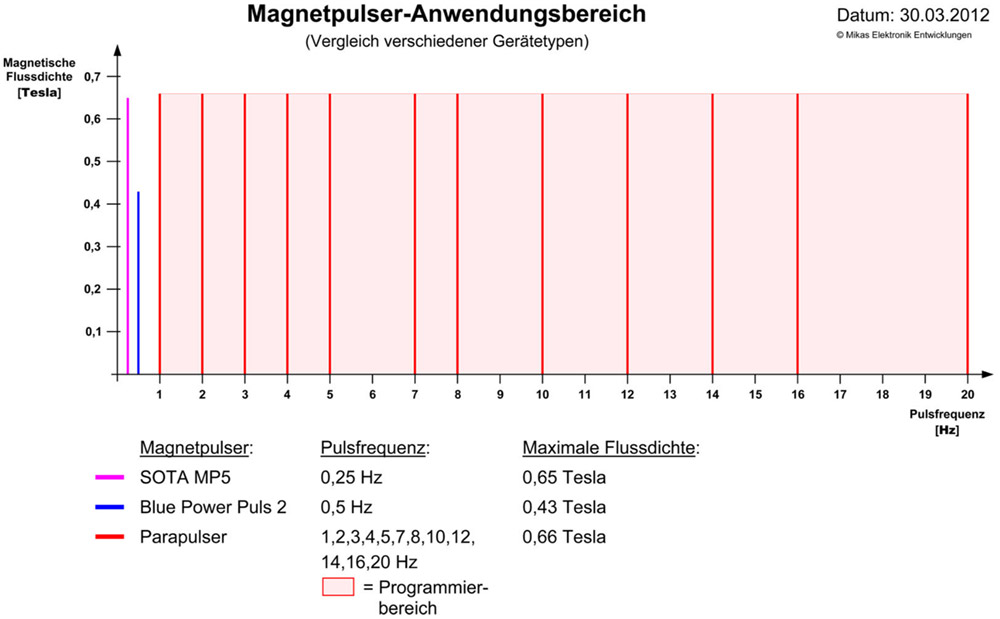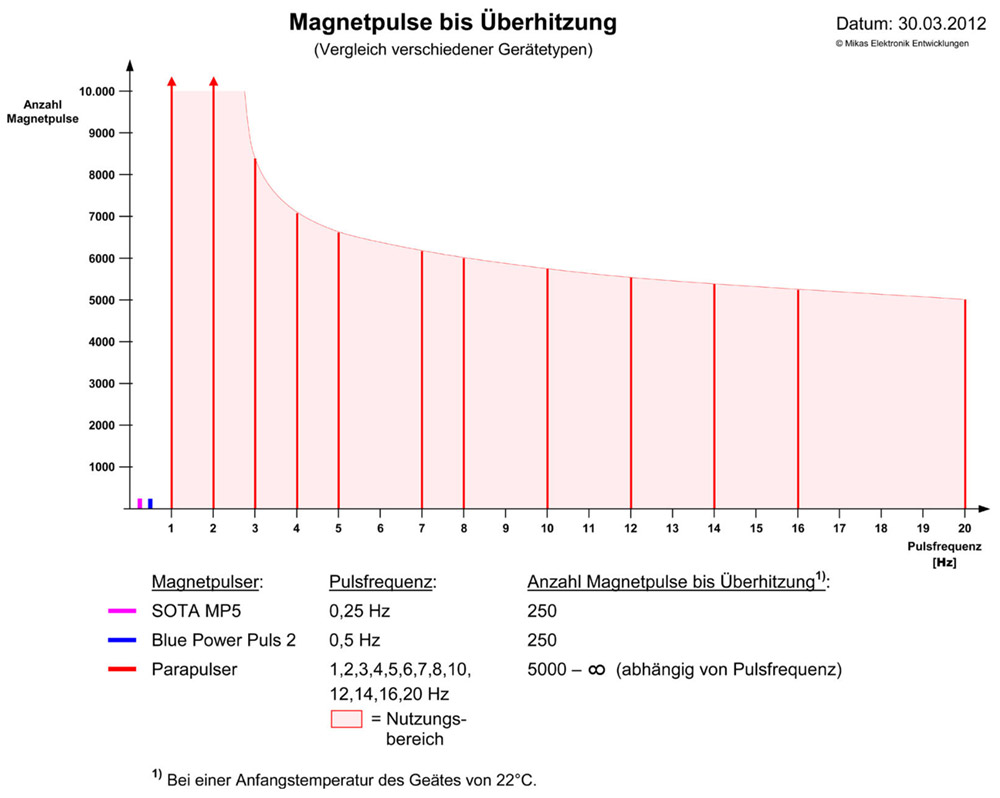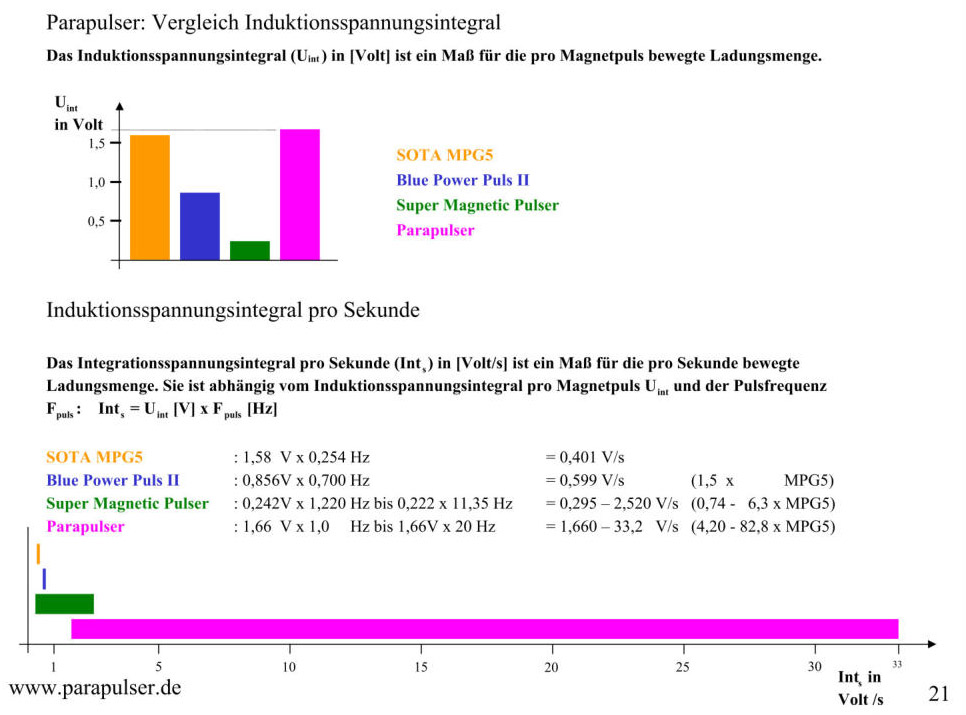
Comparing the Parapulser® BASIC (2 Hz) unit with the strongest pulser so far, the SOTA Instruments magnetic pulser SOTA MPG6, reveals the following differences:
Pulse frequency:
2.00 Hz / 0.23 Hz = PP is 8.7 times faster
Mag flux density:
0.664 T / 0.632 T = PP is 1.05 times stronger
Pulse raise:
469 ms / 953 ms = PP is 2.03 x faster
Pulse fall:
512 ms / 4532 ms = PP is 8.85 times faster
Pulse steepness
overall difference: 2.03 + 8.85 = PP is 10.88 x steeper.
The Parapulser® BASIC (2 Hz) device with its 2 Hz already offers 8 times the induction power compared to the magnetic pulser MPG6 from SOTA INSTRUMENTS. Accordingly, the PRO (20 Hz) version with 20 Hz offers about 80 times the induction power.
*Magnetic induction is the generation of an electric current in a conductive medium, resulting from the fact that a changing magnetic field moves electrically charged particles (electrons / ions) (= law of induction). A current generated in this way is called therefore “induced current”. With the help of induction currents, certain effects can be exerted on the tissue and the body cells. The induction capacity i.e., the amount of energy that can be generated per time unit is directly dependent on the pulse frequency (in Hz), the rate of change of magnetic flux density (dT / dt), and the duration of the magnetic field change (in milliseconds).
**) The induction-effective rise and fall times are measured here in the time window of 10 – 90% of the amplitude in order to be able to compare them meaningfully.
For the application to the body, the following factors are crucial:
- A rapid change of the magnetic field, i.e., possibly rapid build-up and desctruction of the magnetic field, because the greater is the induced current in the body and thus its effectiveness.
- A high maximum flux density, because this is decisive for the depth of the magnetic pulse. The magnetic field decreases with the cube of the distance!
TIME COMPARISON
Treatment with a standard magnetic pulse generator was characterized by extremely long waiting times between the individual pulses. This is due to the long capacitor charging times of 2-5 seconds between the individual pulses. The Parapulser® heralds a new age of time here: The induction, which the SOTA MPG6 achieves in 20 minutes (= 1200 seconds) with approx. 300 pulses and 0.25 Hz pulse frequency, is reached by the Parapulser® at the maximum level (20 Hz) in just 15 seconds. On the other hand, the comparison is even more dramatic: For the induction that the Parapulser® generates in the body at 20 Hz in only 5 minutes, a continuous treatment of 400 minutes or 6.7 hours would be necessary with the MPG6. If one adds to this the cooling pauses of at least 30 minutes per 20 minutes of pulsed operation, this increases the uninterrupted application time of the MPG6 to approximately 17 hours.
PRICE COMPARISON
Even the BASIC (2 Hz) version of the Parapulser® offers eight times the induction power of the SOTA MPG6 magnetic pulser for 399,- €, and is now – taking the postage into account – even 7% cheaper.
PULSE FREQUENCY COMPARISON
The diagram on the left shows in comparison the number of magnetic pulses that can be generated until the magnetic pulses are switched off to avoid overheating and skin burns. Here again, the Parapulser® wins with well over 10,000 pulses in 2 Hz mode (8 times faster than the SOTA MPG6 magnetic pulse generator) and with up to 6,000 pulses in 20 Hz mode, while both the SOTA MPG6 and the “Blue Power Pulse 2” remain below the 300 pulse mark until the switch-off temperature (43°C at the coil head) is reached. The required cooling pause is 30 to 45 minutes and can be shortened by cooling pads placed around the coil head.
PULSE STEEPNESS COMPARISON
The chart above shows the pulse curves. While Parapulser and SOTA come close to each other, the pulse curves of Blue Power Pulse II and the Australian Super Magnetic Pulser remain far behind. However, the strength (in Tesla) is essential for the penetration depth, as this decreases with the cube of the distance (see above).
PARAPULSER: INDUCTION PERFORMANCE COMPARISON
World’s first: The induction performance (voltage increase per second) of a pulser, measured directly on its coil surface, was determined and compared with other pulsers for the first time. The superiority of the Parapulser by orders of magnitude is already evident in all clarity. At large distances (> 1 cm), it would even yield much stronger, due to the exponential decay of the magnetic field. Through the clear code (V / s), for the first time, an objective comparison between all types of magnetic pulsers became possible, without having to know a device’s parameters in detail.In the diagram you can see that the Super Magnetic Pulser leaves the other two sub-Hertz pulsers far behind, but it ends, where the Parapulser starts. Moreover, the considerable heat development of the Super Magnetic Pulser at the highest pulse speed, limits its performance significantly.
PARAPULSER: MEASUREMENT CIRCUIT FOR INDUCTION PERFORMANCE
The measurement circuit for the above induction comparison is not trivial, but can be replicated relatively easily with help of the circuit plan. Thus, also competing manufacturers can reconstruct the readings at any time themselves.







